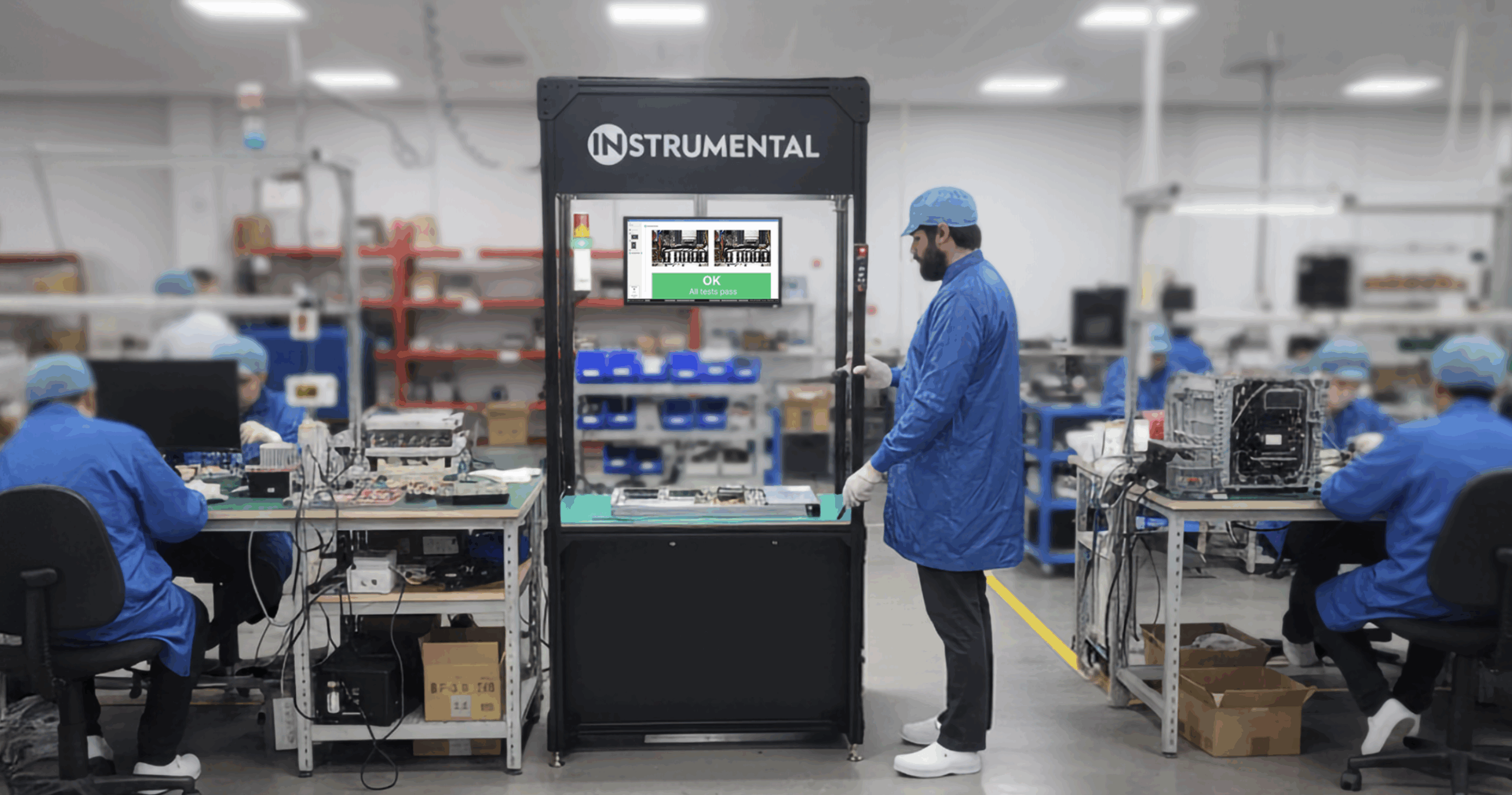It has been over a year since the COVID-19 pandemic halted all business travel. High volume consumer product brands, which were used to regularly sending teams of people overseas, have been forced to rapidly adopt new technologies and processes to keep their programs moving. With these advancements in collaborative remote work, companies are beginning to reset their travel policies so the burden will be on the engineers to justify why they need to go.
With continuing uncertainty around the pandemic and the adoption of new ways to work, what is the threshold for traveling to the factory?
1. When is factory travel critical?
In 2020, 53% of electronics programs were delayed or canceled, but 100% of Instrumental customers shipped. While our solution offers brands the ability to discover, solve, and monitor issues remotely, better communicate with their CM, and hit their build deadlines – sometimes you truly do need an engineer to be there in person. But what should the bar be? If you don’t have Instrumental, here are a few things that usually require an in-person visit.
New in-product technology
Integrating a new technology into a device for the first time means there are a lot of unknowns that can lead to setbacks or failures. It is hard to predict where a problem might occur, or what you might learn from, or where the best places to monitor how the assembly may perform. In these situations, it is important to have the team on-site to observe how the new item behaves, record those observations, and take those learnings to update the team and designs. This is hard to convey without physically watching and handling the technology in the factory environment. If something goes wrong, having the team on-site helps not only to catch the critical issues but to start working on root cause analysis and implementing corrective actions and ways to monitor for the issues in the future. For example, a new flexible display may be fragile and you want your team and factory to understand how critical it is to exercise proper caution in handling, installation, and testing.
New supplier
When awarding business to a new factory, it is critical to send a team to validate they can do the job, but also to see how they work during an NPI build. Spending time in the factory ensures that suppliers are not just putting on a show during a tour but are able to work on their shipping projects while supporting your NPI. You want to set expectations on the amount of communication and transparency about every situation. Factories that attempt to hide problems, or just move through projects without properly troubleshooting problems will need to earn trust.
Quality issues
Sometimes, despite the best processes and testing, quality problems occur. On shipping programs or those about to ship, quality issues can have a huge impact on yields and the ability to get products into sales channels. For quality issues, sending specialists or engineers can help unblock the assembly line as they are able to identify the root cause of a problem while bringing with them the institutional knowledge of the product and goals of the program.
2. Is it safe to travel?*
If remote tools are not enough and you need to travel at this time, the most obvious concern for anyone is health and safety. With every country facing different situations and responses to the virus, it will be essential to have a framework to evaluate the travel risk on a case by case basis.
Case Counts
The Washington Post spoke with experts who said that COVID case counts should be fewer than 5 per 100,000 people to be safe for traveling. This should be evaluated both in the local region as well as the destination to ensure that someone does not catch the disease en route. Also, make sure case counts are trending down so that you have a reasonable assumption that another surge will not occur.
Vaccination and Access to Health Care
Employees who are fully vaccinated for more than 2 weeks will have the best protection possible as they travel abroad. However, some countries, like China, are requiring proof of having taken a Chinese-made vaccine, one that is not currently available in the United States. Even vaccinated people can still become ill with COVID-19 so have a plan in the event of an emergency. Hire or contract a support person or team in the region that can navigate the local healthcare landscape and communicate with HR and the traveler’s family.
Workplace and Lodging Safety
Business travelers spend the majority of their time at the factory, at the hotel, and in transit between the two. A lot of manufacturing takes place in tight quarters with many people sitting close to one another on production lines. Regional health protocols should be enforced and extra caution with masks and sanitizer should be encouraged.
3. How will travel change?
Even when it becomes safe enough to travel, it may not be the same as it once was. The cost and environmental impact of flights are high and CFOs are starting to question the value of business travel now that everything has been done over Zoom for a year. There is no doubt that having boots on the ground can be an invaluable benefit if they can catch significant issues at the build but how do you quantify that? Balancing the increased cost of sending teams, the risks to their health, and the potential delays to a given program is an equation that each company should calculate.
Travel Justification
For a long time, travel has been accepted without question, but there haven’t been good ways to measure the benefits. As a result, many companies sent whole program teams. With travel starting again, albeit more slowly, this could be a great time to incentivize capturing data on the impact engineering teams have abroad. Before sending teams over, determine some simple numbers to track. For example, total issues found, bugs solved, and suppliers visited can be collected and categorized to see where engineers provide the most value. By instituting these policies now, you can gather useful data to justify business travel and optimize the team size for future trips.
Increased Costs
Shifting travel policies in destination countries will make it harder and more expensive to plan each trip. Not only will you need to spend time sifting through guidance from sources including the State Department, the CDC, foreign consulates, and airlines, but any changes could affect your trip and build plans. It might be wise to purchase more expensive refundable tickets in case something changes at the last minute. New visas, COVID tests, and other safety precautions will also add cost and time. Because of all the hassle associated with just getting into foreign countries, it may be prudent to send people on fewer, but longer stays.
Travel Alternatives
Since we have proven in the past year that remote work is possible, the money that was previously allocated to travel budgets may be looking for a new way to be spent. Many companies increased the size of their regional teams to oversee builds and handle communication during the pandemic. Keeping or expanding these resources could be an effective use of money. Additionally, connected, automated tools for the factory are starting to become viable options for overseeing remote NPIs. Capturing relevant data and serving it up in real-time can lead to new opportunities in remote work that were not possible in the travel-first paradigm.
4. Who should travel?
With the risks associated with travel, it is hard to imagine sending whole teams of people over to builds like before. While many engineers enjoyed traveling to the factory in the past, not everyone will have the same risk tolerance now. You need to think about who to send and whether they are willing to go at this time. Who you choose to send will depend as much on their vaccination status as on their ability to wear multiple hats in the factory.
Experienced engineers
With fewer people traveling, those that do will be responsible for checking the material, updating the build plan, bringing up the line, coordinating with the local teams, and communicating changes to the rest of the team. At the same time, if any of these full-stack engineers get sidelined for any reason, you still need someone to lead the build and the team. This could mean altering the structure of your teams to have enough experienced engineers who can travel while keeping enough at home to maintain continuity and oversight of the project.
Early-career engineers
Travel is a great learning opportunity for younger engineers. This on-the-job training is invaluable for understanding how to design and build better products because they can see the impact of their choices in the factories and manufacturing lines. At the same time, these engineers may be among the last to be vaccinated and have the least experience focusing on the important issues at a build. While it can be a great opportunity to assume more responsibility, it doesn’t come without risks. On the other hand, recent grads may not have as many family obligations and have more flexibility to accommodate unexpected changes to their schedules.
Equity
It may be easier for one group of people to travel abroad, and once they do so, it may be easy to keep sending the same people. Certain people will self-select into or out of the opportunity to travel. Be mindful of spreading the opportunities around if there are more volunteers than spots available, and on the flip side, if you have to ask more people to travel, consider incentivizing the trip commensurately with the risk.
5. How can Instrumental help?
Regardless of whether you are eager to send teams abroad or not, the pandemic has exposed some risks in the way products have been built until now. We have relied for too long on engineers to swoop in and fix all the problems at a build without stopping to quantify the return on investment or think of a better way. It is time to take a step back and ask whether there are more effective ways to deploy our engineers while potentially saving money and even speeding up the development process.
Instrumental can be shipped in 4 weeks and begin to proactively find known and unknown issues on your line in hours. That means that we can begin to find potential root causes before they become failures down the line, using AI to identify anomalies in your visuals, functional tests, or other datasets as they are happening. Our virtual tear downs and in-app comment functionality make it easy for engineering teams to conduct failure analysis and collaborate on issue resolution. As Instrumental stations are incredibly easy to set up, factory staff can set the stations up quickly without the need for a brand engineer to be on-site.
Find out more by contacting sales@instrumental.com.
*Disclaimer: this post is not meant to be taken as medical advice. Please consult with your doctor, your organization, and conduct your own research before engaging in travel during these uncertain times.
Related Topics



